NaNoWriMo (National Novel Writing Month) is an annual challenge where you attempt to write a whole “novel” in November. 50,000 words. That requires an average of 1667 (actually 1666.666…) words (5-6 pages) a day for 30 days. Then, at the end, you have a rough draft of a book.
Now, to be sure, that draft is pure rubbish. And probably too short, unless you’re writing middle grade. Even YA is usually 60,000+ words. So it has to be heavily revised and greatly expanded upon. But the main point is that you have something substantial to work on. It can be regarded as a very long synopsis with some actual scene writing. Most writers need that first draft to start the hard part of writing. Recognition of the value of that draft is clear in that it even has a nickname: “shitty first draft.”
Anyway, NaNo’s really hard. Each year tens of thousands sign up (in 2010 it topped 200,000 and last year there were 384,126 participants). And each year a small fraction of those people actually “win” (i.e. write at least 50,000 words). Last year it was less than 9%. The website allows you to track your word count and interact with other participants on forums. It even helps people coordinate to interact in real life (such as in “write-ins” where people get together to write).
But I’ve found NaNo both helpful and fun. I never participate on the forums, but it’s fun to watch my friends’ word counts go up. I’ve done it four years in row now (winning each time) and am about to start my fifth one. I used to have trouble getting myself to actually write. NaNo sort of trained me to write every day. Outside of November, I don’t write quite so much, but I do spend at least a couple hours doing writing-related work almost every day, with more on weekends. NaNo’s also good to break the habit most amateur writers have of constantly going back to the beginning to fix what they’ve realized needs to be changed—thus never making it past the first third of the book or so… You have to just forge ahead, no matter what you realize you’ll have to go back and change (after you get to the end of that first draft).
I’m scrambling to get ready, tweaking my 40-page synopsis (really, a scene-by-scene breakdown) after some feedback from my critique group. It’s going to be another YA novel, though I’m also trying to get a draft of a different novel ready for a beta reader since I won’t have time in November and she’s ready to read. And on top of that, I have two blogs that I post weekly to, so I’m trying to get some reviews ready for those (which means I’m trying to read a bunch, too). Just a few days left to get it all ready. I’m excited to start the new YA novel, which is going to be somewhat autobiographical, but also nervous because some of it’s going to be hard to write. However, people say writing about unpleasant memories can be therapeutic, so we’ll see.
 I don’t remember how I found out about this graphic novel, but I’m glad I did, because it was highly entertaining. Although art is generally a matter of personal preference, I liked it. The book features Nimona, a shapeshifter whose base form is that of a teenage girl, and Ballister Blackheart, the kingdom’s purported notorious villain. Blackheart has a vendetta against Ambrosius Goldenloin, who destroyed Blackheart’s right arm. These are the folks you see on the cover. The comic is set in a vaguely medieval world with advanced science. It’s clever and even subversive at times, all while managing to be hilarious.
I don’t remember how I found out about this graphic novel, but I’m glad I did, because it was highly entertaining. Although art is generally a matter of personal preference, I liked it. The book features Nimona, a shapeshifter whose base form is that of a teenage girl, and Ballister Blackheart, the kingdom’s purported notorious villain. Blackheart has a vendetta against Ambrosius Goldenloin, who destroyed Blackheart’s right arm. These are the folks you see on the cover. The comic is set in a vaguely medieval world with advanced science. It’s clever and even subversive at times, all while managing to be hilarious.


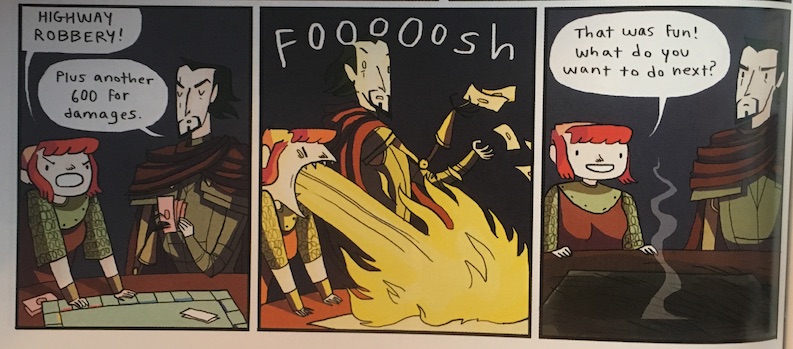

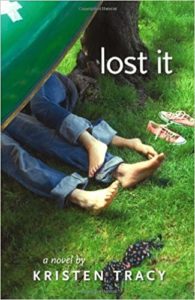 The back blurb sets this book up as very comical. Although the book does have funny moments, that’s a little misleading, as it’s not nonstop laughs. It’s clear from the setup at the very beginning that it’s really about a girl losing her virginity and everything leading up to (and following) that, and it’s serious to her. The title therefore sums it up pretty well, although the title does tie into some other losses in the book, as well. There were a couple other storylines, but the romance between Tess and Ben predominates.
The back blurb sets this book up as very comical. Although the book does have funny moments, that’s a little misleading, as it’s not nonstop laughs. It’s clear from the setup at the very beginning that it’s really about a girl losing her virginity and everything leading up to (and following) that, and it’s serious to her. The title therefore sums it up pretty well, although the title does tie into some other losses in the book, as well. There were a couple other storylines, but the romance between Tess and Ben predominates. This is quite a book, very addictive. It’s a debut, too, which makes it extra surprising, because it feels a little masterful. It’s a tricky psychological thriller with four unreliable narrators. Actually, I’m not sure if the label “psychological thriller” quite fits because it’s not particularly intense like you’d expect with a thriller. Although the book messes with your head, it’s a little mellow compared to Gillian Flynn’s books and The Girl on the Train, I think because there’s more of a sense of danger in those than in One of Us Is Lying. In this book, the mystery is at the forefront. Who killed Simon and how are they hiding that from us despite the fact that we’re in their heads?
This is quite a book, very addictive. It’s a debut, too, which makes it extra surprising, because it feels a little masterful. It’s a tricky psychological thriller with four unreliable narrators. Actually, I’m not sure if the label “psychological thriller” quite fits because it’s not particularly intense like you’d expect with a thriller. Although the book messes with your head, it’s a little mellow compared to Gillian Flynn’s books and The Girl on the Train, I think because there’s more of a sense of danger in those than in One of Us Is Lying. In this book, the mystery is at the forefront. Who killed Simon and how are they hiding that from us despite the fact that we’re in their heads?
 This story is really about the generational after effects of the restrictions and expectations placed on women in the mid-20
This story is really about the generational after effects of the restrictions and expectations placed on women in the mid-20 A lot of people have someone in their life who has had cancer. This book explores the impact a cancer diagnosis has on an entire family. It focuses on Tess, who’s a studious, artistic, shy, and slightly fashion-averse freshman. She’s constantly in the shadow of her older sister, Kristina, a social butterfly who’s also a star volleyball player. At school, no one knows who Tess is, except for her one friend. Even her mom seems to prefer Kristina.
A lot of people have someone in their life who has had cancer. This book explores the impact a cancer diagnosis has on an entire family. It focuses on Tess, who’s a studious, artistic, shy, and slightly fashion-averse freshman. She’s constantly in the shadow of her older sister, Kristina, a social butterfly who’s also a star volleyball player. At school, no one knows who Tess is, except for her one friend. Even her mom seems to prefer Kristina. This book has been out a few years but I only just now discovered (thanks, Amazon recommendations). I’m glad I found it because it’s really good. Ockler writes beautifully, with description that really sets the scene and really gives you a sense of the emotions at play here. Most of the book takes place at the beach and the atmosphere is really powerful. When the characters discuss the majesty of the sea, I could really see and feel it, for instance.
This book has been out a few years but I only just now discovered (thanks, Amazon recommendations). I’m glad I found it because it’s really good. Ockler writes beautifully, with description that really sets the scene and really gives you a sense of the emotions at play here. Most of the book takes place at the beach and the atmosphere is really powerful. When the characters discuss the majesty of the sea, I could really see and feel it, for instance. I listened to the audiobook version of A.S. King’s Ask the Passengers and a friend recommended another of her books, so when I was at Powell’s* when I was in Portland (Oregon) last weekend and spotted this book, I picked it up.
I listened to the audiobook version of A.S. King’s Ask the Passengers and a friend recommended another of her books, so when I was at Powell’s* when I was in Portland (Oregon) last weekend and spotted this book, I picked it up. Frankie’s such a great character. She’s so 15—new to many things and trying to navigate a world with changing expectations. And she’s smart and notices things (regarding a party she was excited to be invited to, and frustrated to be ignored at: “The party was boring. It was people standing around in the cold.”), even though she doesn’t generally over-analyze. She is going into her sophomore year at an elite boarding school with a new, woman-ified body after spending her freshman year as an awkward girl (over the summer, she “gained four inches and twenty pounds, all in the right places”). And a feminism-inspired sense of right and wrong is blossoming within her, as well, partially because of her Berkeley-bound feminist sister and partially because it’s just who she really is. The last point is the best part to me. She’s not willing to accept the status quo when it’s not fair.
Frankie’s such a great character. She’s so 15—new to many things and trying to navigate a world with changing expectations. And she’s smart and notices things (regarding a party she was excited to be invited to, and frustrated to be ignored at: “The party was boring. It was people standing around in the cold.”), even though she doesn’t generally over-analyze. She is going into her sophomore year at an elite boarding school with a new, woman-ified body after spending her freshman year as an awkward girl (over the summer, she “gained four inches and twenty pounds, all in the right places”). And a feminism-inspired sense of right and wrong is blossoming within her, as well, partially because of her Berkeley-bound feminist sister and partially because it’s just who she really is. The last point is the best part to me. She’s not willing to accept the status quo when it’s not fair.



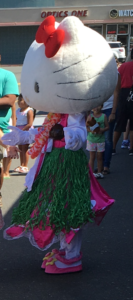

 What I Saw and How I Lied is an interesting historical, set just after WW II. It features quietly bold 15-year-old Evie, whose mother is a bombshell while Evie herself is a bit plain. And she’s not happy about it. Her stepfather is a charming sort but when he gets frustrated by something, they take off in the car and head from Brooklyn to Palm Beach, Florida. There, Evie learns a lot of surprising and not-so-nice things about the world and her parents. She also meets a man who she falls for, despite the fact that he’s 8 years older. It eventually seems to her that pretty much everything she believed about her parents and their life together was a lie. Then she’s put in a position no one wants to be: she has to betray someone—but will it be her parents or the man she’s fallen in love with? And what about the truth—how important is that compared to family loyalty?
What I Saw and How I Lied is an interesting historical, set just after WW II. It features quietly bold 15-year-old Evie, whose mother is a bombshell while Evie herself is a bit plain. And she’s not happy about it. Her stepfather is a charming sort but when he gets frustrated by something, they take off in the car and head from Brooklyn to Palm Beach, Florida. There, Evie learns a lot of surprising and not-so-nice things about the world and her parents. She also meets a man who she falls for, despite the fact that he’s 8 years older. It eventually seems to her that pretty much everything she believed about her parents and their life together was a lie. Then she’s put in a position no one wants to be: she has to betray someone—but will it be her parents or the man she’s fallen in love with? And what about the truth—how important is that compared to family loyalty?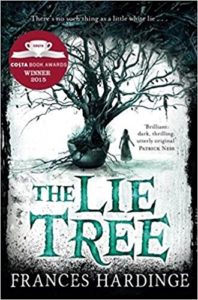 The Lie Tree is a fascinating and unusual book. The idea of the lie tree itself is interesting and creative. The novel touches on feminism, the nature of lies and truth, growing up, knowing yourself, familial love, and fairness. There’s a sense of foreboding throughout that escalates and escalates until the climax. It took me a while to read, but I think that’s because it made me so nervous for the main character, Faith Sunderly, that I would have to set it down. As I neared the end of the book, it was hard to see what would happen next. It’s usually categorized as dark fantasy, but I’d say it’s at least pseudo-horror for the effect it had on me.
The Lie Tree is a fascinating and unusual book. The idea of the lie tree itself is interesting and creative. The novel touches on feminism, the nature of lies and truth, growing up, knowing yourself, familial love, and fairness. There’s a sense of foreboding throughout that escalates and escalates until the climax. It took me a while to read, but I think that’s because it made me so nervous for the main character, Faith Sunderly, that I would have to set it down. As I neared the end of the book, it was hard to see what would happen next. It’s usually categorized as dark fantasy, but I’d say it’s at least pseudo-horror for the effect it had on me.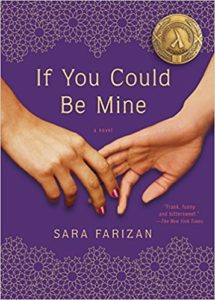 If You Could Be Mine is set in modern-day Iran, which is definitely a setting I’m not very familiar with, so I was excited to read it. It’s narrated by Sahar, a seventeen-year-old lesbian, which is not okay in Iran. In fact, it’s illegal and the penalty can be as dramatic as death. The immediate problem for Sahar is that she has been in love with her friend Nasrin for as long as she can remember, and Nasrin loves her back. Of course, they spend a lot of time alone and this allows them to make out uninterrupted, so everything is fine.
If You Could Be Mine is set in modern-day Iran, which is definitely a setting I’m not very familiar with, so I was excited to read it. It’s narrated by Sahar, a seventeen-year-old lesbian, which is not okay in Iran. In fact, it’s illegal and the penalty can be as dramatic as death. The immediate problem for Sahar is that she has been in love with her friend Nasrin for as long as she can remember, and Nasrin loves her back. Of course, they spend a lot of time alone and this allows them to make out uninterrupted, so everything is fine.